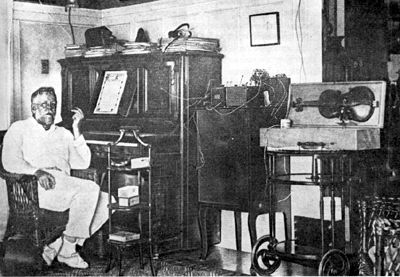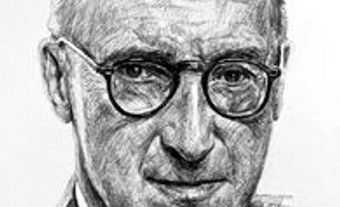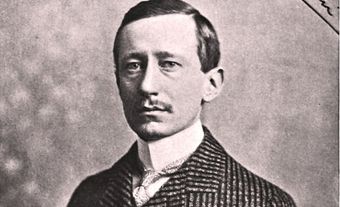Reginald Aubrey Fessenden, electrical engineer (born 6 October 1866 in East Bolton, Canada East; died 22 July 1932 in Hamilton, Bermuda). Fessenden was a pioneer in the field of radio communication. He made the first voice transmission over radio waves. He also laid the foundations of amplitude modulation (AM) and achieved the first two-way radiotelegraphic communication across the Atlantic Ocean. His 1906 transmission of a Christmas concert is considered the first radio broadcast in history. (See also Radio Programming)

Early Life and Education
Though born in Quebec’s Eastern Townships, Reginald Fessenden mostly grew up in Ontario. His father, Reverend Elisha Joseph Fessenden, was an Anglican minister. Fessenden’s mother, Clementina Trenholme Fessenden, was a writer. She was the main driving force behind the introduction of Empire Day to Canada in 1898.
Fessenden was a gifted student. He attended several schools in his youth. He left a military school around age 14 to work in a bank because he was still too young to go to college. He later taught math at Bishop’s College School while still taking high school level literature classes. Fessenden also studied natural sciences and won a scholarship at Bishop’s College. However, he left school at age 18 without graduating to take a job as headmaster of the Whitney Institute in Bermuda. It was in Bermuda that Fessenden met and was later engaged to Helen May Trott.
Career
Reginald Fessenden went to New York City in 1886 to seek work with the American inventor Thomas Edison, arguing he was a quick learner. Edison brushed him off at first but the Edison Machine Works company eventually hired him as an assistant tester. Fessenden proved his worth by mastering his work and helping his supervisor. Before the end of the year, Fessenden had been promoted twice. Earning a job with the Edison company at the dawn of modern technology was no small feat for a 20-year-old without credentials.
Reginald married Helen May Trott in 1890. That same year Edison ran into financial trouble, forcing him to lay Fessenden off. This setback was short lived; Fessenden found work as a professor of electrical engineering at Purdue University. In 1893, he helped electrical industry pioneer George Westinghouse install the lighting at the Chicago World’s Fair. Later that year, Westinghouse recruited Fessenden to the Western University of Pennsylvania in Pittsburgh. Fessenden was the first chair of the school’s electrical engineering department. It was during his time in Pittsburgh that Fessenden learned of Guglielmo Marconi’s efforts to send messages over radio waves. This encouraged Fessenden to improve some of the technology Marconi was then testing.
Amplitude Modulation (AM) and Early Experiments
In 1900, Reginald Fessenden took a job with the United States Weather Bureau. The weather bureau wanted to see if radio waves could transmit weather data from remote coastal stations to bureau offices located in cities without laying telephone and telegraph wires. If this worked, then perhaps radio waves could also be used to send and receive weather data from ships at sea. The problem Fessenden had to overcome was that early radio transmitters could only transmit information by telegraphy, using short and long electric pulses to communicate by Morse code. This was impractical for complicated weather information, which inspired Fessenden to experiment.
He combined a basic radio transmitter with a specially designed interrupter linked to an induction coil. Doing so allowed Fessenden to modify the carrier signal’s oscillation strength (amplitude) to include sound signals. Fessenden had discovered the principle of amplitude modulation (AM).
On 23 December 1900, at Cobb Island, Maryland, Fessenden successfully transmitted his voice over a distance of 1.6 km (one mile) for the first time using amplitude modulation. His message was “Hello. One, two, three, four. Is it snowing where you are, Mr. Thiessen?” The sound was of poor quality, but this was nonetheless an incredible scientific breakthrough. Fessenden also made another important discovery, namely the electrolytic detector, which he patented as the “barretter detector” in 1903. The electrolytic detector improved the reception of sounds over radio waves. Fessenden’s radio detectors were standard in the very early years of radio.
Fessenden eventually quit the Weather Bureau in a bitter dispute over patents. He then formed the National Electric Signalling Company (NESCO). While he had little success with this business, he managed to compete with Marconi’s advances in wireless radio technology. Both inventors sought wireless alternatives to existing transatlantic cables.
From 1903 to 1906, Fessenden helped the Ontario Power Company (later renamed Hydro-Electric Power Commission of Ontario in 1906 and forerunner to Ontario Hydro) develop a hydroelectric power plant at Niagara Falls.
First Radio Broadcasts
Radio technology advanced quickly in the early years of the 20th century. Improvements were made to increase the distance of transmissions, the strength of the signal and the quality of the reception. Improving equipment reliability for communicating was also an important concern.

By the summer of 1906, Reginald Fessenden was experimenting with an alternator-transmitter to transmit voice between two locations in Massachusetts — Brant Rock and Plymouth — which were 18 km apart. Fessenden also established a station at Machrihanish in Scotland for transatlantic experiments.
In November of 1906, Helen Fessenden sent a coded telegraph message via “wireless” (as radio was then called). The message was received by the Machrihanish station, decoded, and then re-transmitted by telegraph to Helen’s friends in London. Two days later, a reply was received. This became the first transatlantic personal message sent and received using radio waves. That same month, engineers at the Machrihanish station overheard some experiments being conducted in Massachusetts.

By this point, Fessenden’s experiments were gaining considerable attention and were regularly reported on by the technical and scientific press. He regularly demonstrated his equipment for potential clients —such as the United States Navy, the American Telegraph and Telephone Company, and leading academics. However, a news report from November 1906 worried him, as it cast doubt on his equipment and his claims. On 5 December 1906, the Machrihanish station tower also collapsed in a violent storm. These two events convinced Reginald Fessenden that the time was right to demonstrate his equipment to the press and a select group of invited guests. The first public demonstration of music and speech broadcast happened on 21 December 1906. The event was reported in a leading technical journal early the following year. Days later, Fessenden asked ships of the U.S. Navy and the United Fruit Company to listen in on Christmas Eve and New Year’s Eve for a special program of music, speech and singing. He broadcast the holiday programs from the Brant Rock transmitter tower to the electrolytic detectors installed on those ships.
Fessenden claimed that the Christmas Eve broadcast was heard as far south as Norfolk, Virginia, and that the New Year’s Eve broadcast was heard as far south as the Caribbean Sea. These are considered the first broadcasts in the history of radio.
Later Life
Though Reginald Fessenden had made many important discoveries and accumulated over 500 patents in his lifetime, he was never an astute businessman. The formation of the Fessenden Wireless Company of Canada in Montreal in 1906 led to a series of problems between Fessenden and his financial backers. These problems led to his dismissal by the National Electric Signalling Company’s board of directors in 1911. The legal case wasn’t resolved until 1928.
From 1912 to 1921, Fessenden worked as a consulting engineer with the Submarine Signal Company of Boston. Some of his research in these years led to the development of sonar.
In 1928, Fessenden used the large cash settlement from his legal case to buy a small estate in Bermuda. He lived there until his death at age 65 on 22 July 1932.
Tributes
The Society of Exploration Geophysicists has given an annual award in Reginald Fessenden’s name since 1977. Purdue University’s School of Electrical and Computer Engineering has offered the Fessenden-Trott Scholarship since 1980. Fessenden’s house in Newton, Massachusetts, is a National Historic Landmark and listed on the National Register of Historic Places. In Austin, Quebec, near the village of East Bolton where Fessenden was born, stands a commemorative plaque.

 Share on Facebook
Share on Facebook Share on X
Share on X Share by Email
Share by Email Share on Google Classroom
Share on Google Classroom



